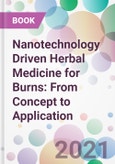Nine chapters deliver updated information about nanomedicines for burn wound therapy. Contributions are written by experts in nanomedicine and phytomedicine and collectively cover the pathophysiology of wound lesions, current and future outlook of nanomedicine based treatments for burn wound lesions, the role of biocompatible nanomaterials in burn wound management, plant-mediated synthesis of metal nanoparticles for treating burn wound sepsis, phytomedicine based nanoformulations and the phyto-informatics models involved in the wound healing process which are used to select appropriate nanotherapeutic agents. This reference serves as an accessible source of information on the topic of nanomedicine for burn treatments for all healthcare professionals (medical doctors, nurses, students trainees) and researchers in allied fields (pharmacology, phytomedicine) who are interested in this area of medicine.
Table of Contents
Chapter 1 Current Status And Future Outlook Of Nanotechnologybased Therapeutic Treatment Modalities For Burn Wound Management- Rana Mazumder And Subhabrota Majumdar
- Introduction
- Skin
- Physiology For Burn Wounds
- Burn Wound Healing
- Nanomedicine And Advancement In Therapy For Burn Wound Management
- Metallic Nanoparticles
- Polymeric Nanoparticles
- Liposomal Nanoparticles
- Nanoemulsion
- Nanogels
- Wound Dressings
- Tissue Engineering
- Nanostructured Topical Drug Delivery Recent Advancement As Burn Wound Therapy
- Concluding Remarks And Future Prospect
- Consent For Publication
- Conflict Of Interest
- Acknowledgements
- References
Chapter 2 Nanotechnology- Mediated Delivery Of Phytomedicine For Burn Wound Healing
- Mohammed Aslam, Mohammad Zaki Ahmad, Abdul Aleem Mohammed, Harshita, Md. Abul Barkat And Javed Ahmad
- Introduction
- Significance Of Nanotechnology-Mediated Delivery Of Phytomedicine
- Delivery Of Phytomedicine Exploiting Nanotechnology In Burn Wound Healing
- Berberine
- Bromelain
- Silymarin
- Madecassoside
- Resveratrol
- Epigallocatechin
- Curcumin
- Aloe Vera
- Conclusion
- Consent For Publication
- Conflict Of Interest
- Acknowledgements
- References
Chapter 3 Plant Mediated Green Synthesis Of Silver Nanoparticles For Burn Wound Infections
- Katayoon Kalantar, Alireza Kalantari And Thomas J. Webster
- Introduction
- Plant-Based Synthesis Of Ag-Nps
- Mechanism Of Plant-Mediated Synthesis Of Ag-Nps
- Ag-Np Characterization Techniques
- Cytotoxicity Of Plant-Mediated Ag-Nps
- Antimicrobial Activities Of Plant-Mediated Ag-Nps
- Wound Healing Process
- Wound Healing Applications Of Ag-Nps
- Side Effects Of Silver Use
- Summary And Future Prospects
- Consent For Publication
- Conflict Of Interest
- Acknowledgements
- References
Chapter 4 Therapeutic Prospective Of Green-Synthesized Silver Nanoparticles In Burn Wound Management
- S. Sumathi
- Introduction
- Wound Healing
- Agnps As Antimicrobial Agents
- Green Synthesis Of Agnps
- Characterization Of Agnps And Its Applications
- Plant Mediated Synthesis Of Agnps And Its Wound Healing Activity
- Microbial Organism Mediated Agnps And Its Wound Healing Activity
- Mechanism Of Action Of Antibacterial Activity
- Concluding Remarks
- Consent For Publication
- Conflict Of Interest
- Acknowledgement
- Reference
Chapter 5 Phytochemical-Assisted Gold Nanoparticles For Burn Wound Management
- Abdelgadir A. Abdelgadir And Pooja A. Chawla
- Introduction
- Gold Nanoparticles Potential Therapeutic Effects On Wound Healing
- Green Synthesis Of Gold Nanoparticles And Characterization
- Wound Healing Mechanism Of Phytochemical-Assistedgold Nanoparticles
- In Vitro Studies
- In Vivo Studies
- Concluding Remarks
- Consent For Publication
- Conflict Of Interest
- Acknowledgements
- References
Chapter 6 Therapeutic Importance Of Phyto-Assisted Green Synthesis Of Zinc Oxide Nanoparticles In Burn Wound Management
- Md. Abul Barkat
- Introduction
- Phyto-Assisted Green Synthesis Of Zinc Oxide Nanoparticles
- Therapeutic Potential Of Phyto-Assisted Znonps In Burn Wound
- Conclusion
- Consent For Publication
- Conflict Of Interest
- Acknowledgement
- References
Chapter 7 Plant Mediated Synthesis Of Titanium Dioxide Nanoparticles For Burn Wound Management
- Abdelgadir A. Abdelgadir And Pooja A. Chawla
- Introduction
- Nanoparticle's Potential Therapeutic Effects On Wound Healing 118 Green Synthesis Of Titanium Dioxide Nanoparticles And Characterization
- Titanium Dioxide Plant-Based Nanoparticles
- Applications Of Plant Titanium Dioxide Nanoparticles For Wound Healing
- In Vitro Studies
- In Vivo Studies
- Concluding Remarks
- Consent For Publication
- Conflict Of Interest
- Acknowledgements
- References
Chapter 8 Toxicity Related To Phytochemical-Assisted Metallic Nanoparticles In Burn Wound Management
- Lubna Abidin, Mohd. Mujeeb And Md. Abul Barkat
- Introduction
- Classification Of Burn Wounds
- The Restoration Cascade
- Nanoparticles In Burn Wound Treatment
- Penetration Of Pmnps Through Dermal Route
- Intracellular Pathway
- Intercellular Pathway
- Follicular Pathway
- Toxicity Caused By Pmnps In Burn Wounds
- Mechanism Of Pmnps Toxicity
- Production Of Ros
- Inflammatory Cascade
- Genotoxicity
- Autophagy
- Apoptosis
- Epigenetic Effects
- Phototoxicity
- Neurotoxicity
- Skin Sensitivity By Metallic Nps
- Conclusion
- Consent For Publication
- Conflict Of Interest
- Acknowledgemnt
- References
Chapter 9 A Novel Herbal Informatic Approach For The Management Of Skin Burn Injury
- Ankit Tanwar, Ruby Sharma, Ayesha Ali Zaidi, Deepti Sharma, Rashmi Wardhan Raman Chawla, Himanshu Ojha, Rajesh Arora And Haider Ali Khan
- Introduction
- Types Of Wounds And Their Healing Mechanism
- Side Effects Of Skin Burn Injury
- Biomarkers Of The Skin Wounds
- Methodology
- Classic Literature Surge Model
- Evaluation Of Relevance Factor Using ‘Keywords Hits' Scoring Matrix Approach
- Binary Coefficients Matrix To Assess The Presence/Absence Of A Bioactivity Parameter (Bap)
- Weightage Matrix-Based Analysis
- Fuzzy Set Optimization For The Decision Matrix
- Results
- Bioactivity Parameters Analysis Using The Classical Approach
- Keywords Hit Scoring Matrix Approach To Evaluate The Relevance Factor
- Simple Additive Weighting Matrix
- Decision Matrix-Based Optimization
- Discussion
- Conclusion
- Consent For Publication
- Conflicts Of Interest
- Acknowledgement
- References
- Subject Index
Author
- Md. Abul Barkat
- Sarwar Beg
- Farhan Jalees Ahmad








